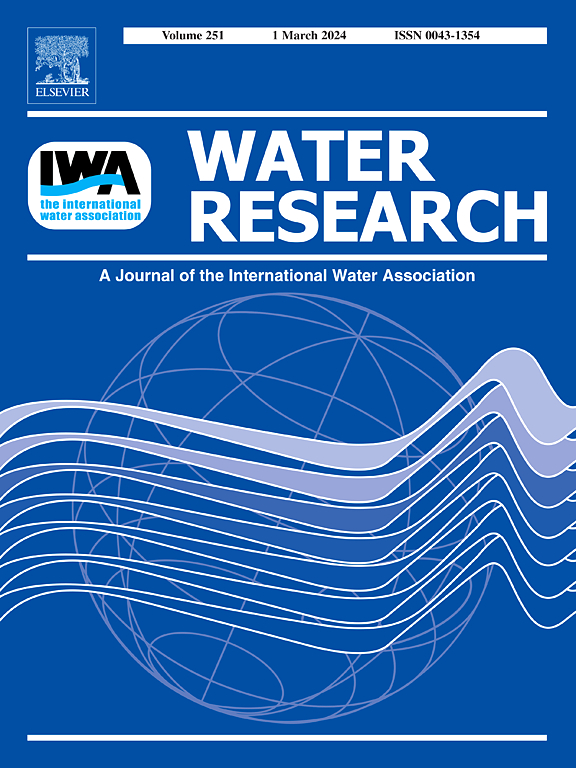Hidden risks: Unrecognized biological toxicity and antibiotic resistance spread in peracetic acid-based advanced wastewater treatment technologies
IF 12.4
1区 环境科学与生态学
Q1 ENGINEERING, ENVIRONMENTAL
引用次数: 0
Abstract
The escalating concern over antibiotic resistance in wastewater demands urgent attention. While advanced treatment technologies are anticipated to enhance secondary effluent quality and mitigate this issue, the associated biological toxicity and potential for resistance spread have been largely neglected. Herein, we explored the impact of peracetic acid (PAA)-based processes on antibiotic resistance during advanced secondary effluent treatment. Our findings revealed that PAA effectively inactivated most wastewater bacteria. However, it simultaneously induced environmental biotoxicity and genotoxicity, triggering a 1.5–2-fold increase in extracellular ARGs (eARGs) release and doubling horizontal gene transfer frequency. In contrast, PAA-based advanced oxidation process (PAA-AOP) demonstrated strong efficacy in detoxifying antibiotics and minimizing harm to aquatic organisms. It reduced both intracellular and extracellular ARGs by 2–4 orders of magnitude in real wastewater and significantly inhibited the conjugative transfer and transformation frequency of ARGs (by approximately 10 times), impairing their spread. Moreover, PAA-AOP reduced the abundance of pathogenic bacteria in wastewater transconjugants, thus minimizing direct harm to humans. Additionally, a membrane flow-through system designed with PAA-AOP exhibited excellent catalytic performance and stability in removing antibiotics and ARGs. These findings provide key insights into PAA-based advanced wastewater treatment, making a significant contribution to mitigating biotoxicity and antibiotic resistance in aquatic ecosystems.


隐患:未被识别的生物毒性和抗生素耐药性在过氧乙酸基先进废水处理技术中的传播
对废水中抗生素耐药性的日益关注需要迫切关注。虽然先进的处理技术有望提高二级污水的质量并缓解这一问题,但相关的生物毒性和耐药性传播的潜力在很大程度上被忽视了。在此,我们探讨了过氧乙酸(PAA)为基础的工艺对抗生素耐药性的影响,在高级二级污水处理。我们的研究结果表明,PAA可以有效地灭活大多数废水细菌。然而,它同时诱导环境生物毒性和遗传毒性,导致细胞外ARGs (eARGs)释放增加1.5 - 2倍,水平基因转移频率增加一倍。而PAA-AOP在抗菌解毒和减少对水生生物的危害方面表现出较强的效果。它将实际废水中的胞内和胞外ARGs降低了2-4个数量级,并显著抑制了ARGs的共轭转移和转化频率(约10倍),损害了它们的传播。此外,PAA-AOP降低了废水转偶联物中病原菌的丰度,从而最大限度地减少了对人类的直接危害。此外,PAA-AOP设计的膜流系统在去除抗生素和ARGs方面表现出优异的催化性能和稳定性。这些发现为paa基高级废水处理提供了关键见解,为减轻水生生态系统中的生物毒性和抗生素耐药性做出了重大贡献。
本文章由计算机程序翻译,如有差异,请以英文原文为准。
求助全文
约1分钟内获得全文
求助全文
来源期刊

Water Research
环境科学-工程:环境
CiteScore
20.80
自引率
9.40%
发文量
1307
审稿时长
38 days
期刊介绍:
Water Research, along with its open access companion journal Water Research X, serves as a platform for publishing original research papers covering various aspects of the science and technology related to the anthropogenic water cycle, water quality, and its management worldwide. The audience targeted by the journal comprises biologists, chemical engineers, chemists, civil engineers, environmental engineers, limnologists, and microbiologists. The scope of the journal include:
•Treatment processes for water and wastewaters (municipal, agricultural, industrial, and on-site treatment), including resource recovery and residuals management;
•Urban hydrology including sewer systems, stormwater management, and green infrastructure;
•Drinking water treatment and distribution;
•Potable and non-potable water reuse;
•Sanitation, public health, and risk assessment;
•Anaerobic digestion, solid and hazardous waste management, including source characterization and the effects and control of leachates and gaseous emissions;
•Contaminants (chemical, microbial, anthropogenic particles such as nanoparticles or microplastics) and related water quality sensing, monitoring, fate, and assessment;
•Anthropogenic impacts on inland, tidal, coastal and urban waters, focusing on surface and ground waters, and point and non-point sources of pollution;
•Environmental restoration, linked to surface water, groundwater and groundwater remediation;
•Analysis of the interfaces between sediments and water, and between water and atmosphere, focusing specifically on anthropogenic impacts;
•Mathematical modelling, systems analysis, machine learning, and beneficial use of big data related to the anthropogenic water cycle;
•Socio-economic, policy, and regulations studies.
 求助内容:
求助内容: 应助结果提醒方式:
应助结果提醒方式:


